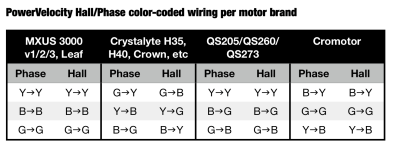I'm using a sensorless heinzmann PMS 80 motor.
I'll double check the ignition wiring tomorrow. I had just connected the two wires to each other with a switch instead of connecting them to a power source. The CycleAnalyst powered up when they were joined together though.
I'll double check the ignition wiring tomorrow. I had just connected the two wires to each other with a switch instead of connecting them to a power source. The CycleAnalyst powered up when they were joined together though.





